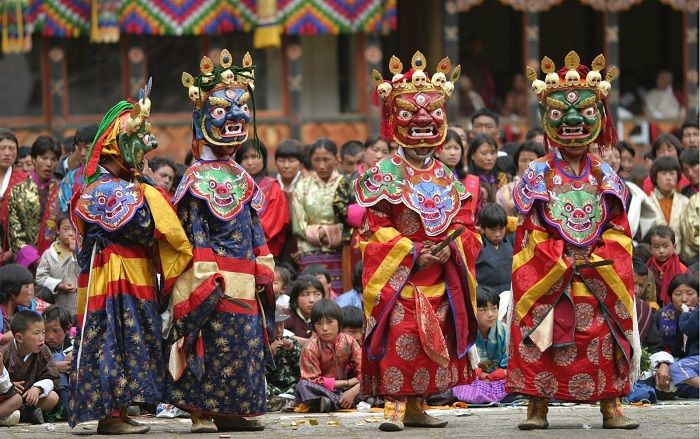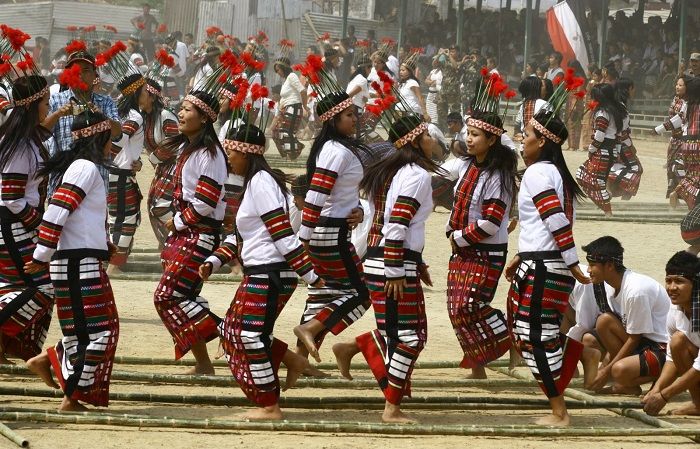Northeast India comprises of eight states, which includes the state of Sikkim and the seven sister states – Arunachal Pradesh, Assam, Meghalaya, Mizoram, Manipur, Nagaland and Tripura. Folk dances in these states are often performed during festivals or to celebrate life. Dance is an important aspect in the lives of people living in this part of the country and hence many age-old dance forms are still practiced and kept alive. Let us now have a look at different folk dances of Northeast India.
Bardo Chham
Region/Area: Arunachal Pradesh
Occasion: Performed during festivals
Highlight: The performers wear masks representing different animals
Purpose: Depiction of good over evil
Bardo Chham is performed by the Sherdukpen tribe of the West Kameng district. The dancers wear masks of 12 different animals and perform to the beats of many percussion instruments. Sherdukpen tribe believes that there are 12 different evil forces and they all appear in different months to mar the happiness of the community. The masks represent evil forces and the main objective of this art form is to ward off these evil forces. Men and women don colorful clothes before showcasing their dancing skills.

Ponung
Region/Area: Arunachal Pradesh
Occasion: Performed before harvesting crops
Highlight: Only one musical instrument called ‘Yoksha’ is used
Ponung is one of the most important folk dances of Arunachal Pradesh. Performed before the harvest of staple crops, it has women dancers. They often hold each other’s hand and dance in formations. These dancers are led by a man who sings various songs and uses a sword-like musical instrument known as ‘Yoksha.’ This is the only instrument used in the entire act. The participants wear traditional dresses, which comprises a long black-colored shirt and red-colored skirt-like garment.
Wancho Dance
Region/Area: Arunachal Pradesh
Occasion: Performed during festivals
Highlight: Men and women take turns to sing, which is quite unique in folk dances of this region
This dance is performed by the Wancho tribe during festivals or important cultural events. The dancers wear traditional attire with the men folk wielding a sword in their right hand. The performance usually begins when the men start singing and dancing. They follow a peculiar dance step which involves thrusting of the sword. Once they finish, the women start dancing and their song is usually a reply to the song sung by the men folk. The whole process is repeated over a certain period of time.

Buiya Dance
Region/Area: Arunachal Pradesh
Occasion: Performed to entertain others
Highlight: This dance has a unique formation
Performed by the Digaru Mishmis of Arunachal Pradesh, Buiya dance is the main attraction of many tribal festivals. Women dancers stand in a straight line before commencing the act, thus paving the way for a strange formation. Men support the performance by playing different instruments like drums, gongs and cymbals.
Bihu
Region/Area: Assam
Occasion: Performed during the Bihu festival
Highlight: Lyrics used in the songs propagates love
Bihu forms the most important part of the Bihu festival celebration. The dance is performed by young men and women, accompanied by the playing of pipes & drums. Lyrics used in the songs, which supports the dance performance, play a vital role as it propagates love. Dancers are usually seen forming circles or rows before commencing the dance.

Bagurumba
Region/Area: Assam
Occasion: Performed during various festivals
Highlight: The dance is inspired from nature
The Bodo tribe of Assam practices this dance form. Usually performed by women, the dance is accompanied by instruments like drums and flutes. Since Bagurumba is believed to have been inspired from nature, it can be further classified into different dance forms – each inspired from elements of nature like animals, plants, birds, insects, water, air and so on.
Jhumur
Region/Area: Assam
Occasion: Performed to rejuvenate
Highlight: Rhythmic dance moves
While the men play musical instruments, the women dancers place their arms around the waist of the adjacent dancer and sway to and fro in a synchronized manner. The dance is performed by the tribal people who work in tea estates of Assam. Jhumur is often their only recreational activity and this certainly rejuvenates them after a long and tiring day.

Ojapali
Region/Area: Assam
Occasion: Performed to showcase rich tradition of Assam
Highlight: The principal performer called ‘Oja’ is the main attraction
Believed to be one of the most ancient dance forms of Assam, Ojapali is a combination of songs, dance and narration of stories. It is performed by a group of men comprising a leader and his assistants. Among the assistants, one is known as ‘Daina Pali,’ which literally means primary sidekick. The performance conveys stories from the Hindu epics and other religious texts.
Nongkram Dance
Region/Area: Meghalaya
Occasion: Festival
Highlight: The entire performance is colorful and vibrant
The Nongkram dance is performed during the months of May and November by the inhabitants of the Khasi hills. Performed by boys and girls of the region, this particular dance form requires tremendous skills and energy. The dance is a form of paying respects to the deity worshipped by the tribe.

Ka Shad Suk Mynsiem
Region/Area: Meghalaya
Occasion: Festival
Highlight: The festival attracts many people from all over the state
Shad Suk Mynsiem is a dance festival which is celebrated after every successful harvest. The dance is performed by men and unmarried women or young girls. The dancers make two different circular formations with the girls taking the inner circle and the men forming the outer circle. While the dance movements of the girls are subtle in nature, the men make all the difficult moves. Various instruments like flutes, Spanish guitars and a host of percussions are used.
Hojagiri
Region/Area: Tripura
Occasion: Festivals
Highlight: Women balance bottle and earthen lamps on their head
The dance is performed during festivals, such as ‘Laxmi Puja’, ‘Durga Puja’ and the third day of ‘Dusshera’. While women dance gracefully by balancing bottles or earthen lamps on their head, men take care of the musical part. Hojagiri is one of the most important dance forms of Tripura.
Dhol Cholom
Region/Area: Manipur
Occasion: Performed during Holi festival
Highlight: The dancers display acrobatic moves while playing dhol – a large drum
One of the instruments that dominate Manipuri dances is the drum. Dhol Cholom, a drum dance is one of the dances performed during Holi festival in Manipur. The dance is performed by men who display acrobatic moves while playing the dhol. The dance usually begins with a slow tempo and gradually gathers pace.
Cheraw Dance
Region/Area: Mizoram
Occasion: Part of a ritual
Highlight: Performers dance in between bamboo staves
The dance is a set of skillfully formulated moves which involves movement of bamboo staves. While the men move horizontally and vertically held bamboo staves, women dance in between them and the challenge is not to get caught between the staves. The movement of the staves makes a unique beat and it helps the dancers to move accordingly.

Chang Lo
Region/Area: Nagaland
Occasion: Performed to celebrate victory over enemies
Highlight: Dramatic costumes of the dancers make the act interesting
Chang Lo dance is traditionally performed to celebrate victory over an enemy. Since it is a war dance, dancers don costumes worn by warriors and display war tactics. The costumes are often dramatic, which adds color to the entire act. Women on the other hand drool over their heroes and the same is performed in the dance.
Maruni
Region/Area: Sikkim
Occasion: Weddings
Highlight: The performance includes a joker who makes the entire act interesting
Performed by both men and women wearing colorful clothes, Maruni is the main attraction of Sikkim weddings. The performers are accompanied by a joker called ‘Dhatu Waray’ who makes fun of others. Nine different musical instruments, collectively called ‘Naumati Baja,’ are used in the performance. Though the dance traces its origin to Nepal, it forms an important part of the culture of Sikkim as well.




